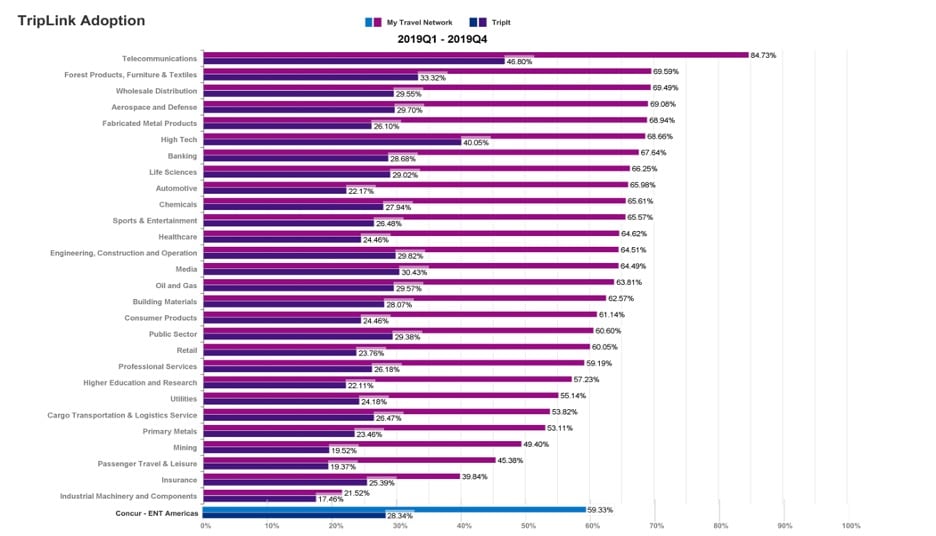Keep Calm and Carry on With a Relevant Duty of Care Program
Knowing where your employees are now, where they are traveling to and how to communicate with them has significantly increased in importance this year. Recent crises have deepened the appreciation that some organizations have for their duty of care programs and have caused others to reevaluate. In fact, 96% expect their employers to proactively take steps to improve traveler safety and lower the stress associated with travel. As we long for the day when COVID-19-specific risk assessments are unnecessary, BTN predicts that travel managers will be in a more central role when it comes to strategic and operational decision-making. Having a plan that reduces risk and increases visibility ensures the safety of your employees and fulfills your organization’s obligation to keep them safe from harm. Comparing the level of adoption of booking tools within your organization to benchmarks of your industry colleagues, paired with ongoing assessment of your travel and expense data, will allow you to offer a relevant duty of care program that minimizes risk for your employees and maximizes communications and visibility when pandemonium erupts.
How did they book that?
The more employees use the booking tools that you provide, the easier it is for you to ensure their safety. Offering employees booking tools will automatically make their travel data visible. However, 31% of organizations still say that they don’t manage data for the purpose of travel risk management. Since many employees still have their preferred ways to book and plan itineraries, comparing the level of adoption of tools like Concur TripLink and My Travel Network (MTN) cross referenced with travel-related expenses will help you get a clear idea of who is booking inside and outside of the system, and still allow you to track all bookings – regardless of where they occur. Review the level of adoption benchmarks below and see how you compare to your industry colleagues:
(click to enlarge)
Course correction towards increased adoption of your preferred booking tools is achievable. One small impact over time is to review your new employee onboarding process. Do you require that they set up a profile and opt into the tools that you offer, like My Travel Network? Based upon your annual onboarding volumes, a small change with new employees could lead to significant improvement of visibility in the future.
Where did they buy that?
When an employee makes a purchase on a corporate card rather than cash, you can leverage this information to know where they are. In the absence of more current information, card data can provide a traveler’s last known location. Additionally, traveling with large amounts of cash can make a traveler a target for criminals. Corporate card usage can serve as a significant line of defense in a duty of care program. While corporate card usage is a valuable spend management tool, you can also evaluate the risk threshold of your duty of care program by reviewing the level of corporate card adoption. By encouraging your employees to use their corporate cards, you’re also adding another layer of their protection from crisis.
When did they book that?
The earlier the booking, the more time you will have to ensure the proper precautions are taken. 93% of executive stakeholders consider traveler safety reports extremely or very important, so having these measures in place is crucial. Even though we live in a completely connected society, advances in technology haven’t really helped us become better planners when it comes to business travel. Review your travel request policy to see if you can balance the planning-to-booking window that prioritizes employee safety.
Who did they ride with?
If you could save your organization money and help your team travel more safely, would you? Of course, you would. Our quick fix: increasing rideshare over other ground transportation options. Travel by car is still one of the primary modes of business travel. Rideshare apps allow travelers to share their route information with others, so others can track their ETA. This is a way that travelers can take ownership of their own safety. Electronic payment within rideshare apps also reduces the need to carry cash and can automatically route data for expense report completion.
How safe is it?
Reviewing the risk levels of a destination using tools such as TripLink, the U.S. Department of State portal, or TripIt neighborhood safety scores before approval, booking, departure, and during travel, prioritizes employee safety and can be a simple check. Determining the right level of safety for your organization and reflecting this in your travel policy will help maintain a risk level that everyone is comfortable with. Considering the request process and incident response procedures, especially in destinations scoring high on the risk levels are valuable steps in your policy review process.
How can you improve?
Actively monitoring where employees are located around the world and having a way to communicate with and assist them during a crisis is no small feat. Encouraging employees to book their travel in advance, using the tools and corporate cards that you provide, will allow your organization to offer a duty of care program that is relevant and effective.
Here are some of our best practices to get started:
- Regularly review your travel and expense data for trends
- Maintain up-to-date employee information
- Provide timely travel advisories (pre-trip and ongoing)
- Ensure ability to identify employee location through a system of data and communication points
Take our Travel Risk Quiz for a personalized score on how well your organization is managing employee risk.
